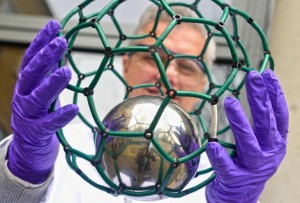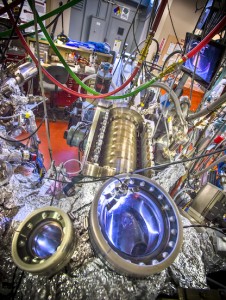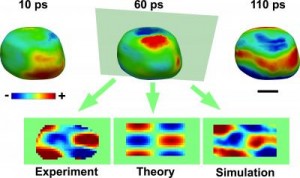Eric Drexler (aka, K. Eric Drexler) is a big name in the world of nanotechnology as per my May 6, 2013 posting abut his talk in Seattle as part of a tour promoting his latest book,
Here’s more from the University Bookstore’s event page,
Eric Drexler is the founding father of nanotechnology, the science of engineering on a molecular level—and the science thats about to change the world. Already, says Drexler, author of Radical Abundance, scientists have constructed prototypes for circuit boards built of millions of precisely arranged atoms. This kind of atomic precision promises to change the way we make things (cleanly, inexpensively, and on a global scale), the way we buy things (solar arrays could cost no more than cardboard and aluminum foil, with laptops about the same)—and the very foundations of our economy and environment.
…
… Drexler’s latest effort, Radical Abundance, here’s what he had to say about the book in a July 21, 2011 posting on his Meta Modern blog,
Radical Abundance will integrate and extend several themes that I’ve touched on in Metamodern, but will go much further. The topics include:
- The nature of science and engineering, and the prospects for a deep transformation in the material basis of civilization.
- Why all of this is surprisingly understandable.
- A personal narrative of the emergence of the molecular nanotechnology concept and the turbulent history of progress and politics that followed
- The quiet rise of macromolecular nanotechnologies, their power, and the rapidly advancing state of the art
- ….
About the same time he was promoting his book, Radical Abundance, the University of Oxford Martin School released a report written by Drexler and co-authored with Dennis Pamplin,, which is featured in an Oct. 28, 2013 news item on Nanowerk (Note: A link has been removed),
The world faces unprecedented global challenges related to depleting natural resources, pollution, climate change, clean water, and poverty. These problems are directly linked to the physical characteristics of our current technology base for producing energy and material products. Deep and pervasive changes in this technology base can address these global problems at their most fundamental, physical level, by changing both the products and the means of production used by 21st century civilization. The key development is advanced, atomically precise manufacturing (APM).
This report (“Nano-solutions for the 21st century”; pdf) examines the potential for nanotechnology to enable deeply transformative production technologies that can be developed through a series of advances that build on current nanotechnology research.
Coincidentally or not, Eric Drexler is writing a series of posts for the Guardian about nanotechnology and the future. Here’s a sampling from his Oct. 28, 2013 post on the Guardian’s Small World Nanotech blog sponsored by NanOpinion,
In my initial post in this series, I asked, “What if nanotechnology could deliver on its original promise, not only new, useful, nanoscale products, but a new, transformative production technology able to displace industrial production technologies and bring radical improvements in production cost, scope, and resource efficiency?”
The potential implications are immense, not just for computer chips and other nanotechnologies, but for issues on the scale of global development and climate change. My first post outlined the nature of this technology, atomically precise manufacturing (APM), comparing it with today’s 3D printing and digital nanoelectronics.
My second post placed APM-level technologies in the context of today’s million-atom atomically precise fabrication technologies and outlined the direction of research, an open path, but by no means short, that leads to larger atomically precise structures, a growing range of product materials and a wider range of functional devices, culminating in the factory-in-a-box technologies of APM.
Together, these provided an introduction to the modern view of APM-level technologies. Here, I’d like to say a few words about the implications of APM-level technologies for human life and global society.
At the bottom of the posting, this is noted,
Eric Drexler, often called “the father of nanotechnology”, is at the Oxford Martin Programme on the Impacts of Future Technology, University of Oxford. His most recent book is Radical Abundance: How a Revolution in Nanotechnology Will Change Civilization
The Oxford Martin School of Oxford University and the Research Center for Sustainable Development of the China Academy of Social Sciences recently released a report on atomically precise manufacturing, Nano-solutions for the 21st century. The report discusses the status and prospects for atomically precise manufacturing (APM) together with some of its implications for economic and international affairs.
Publicity is a beautiful thing, especially when you can tie so many things together. Drexler, his book, the report, and the Guardian’s special section sponsored by NanOpinion.
Getting back to the report, Nano-solutions for the 21st century, I notice that there’s been a lot of collaboration with Chinese researchers and institutions if the acknowledgements are a way to judge these things,
This work results from an extensive process that has included interaction and contributions by scientists,
governments, philanthropists, and forward-thinkers around the world. Over the last three years workshops
have been conducted in China, India, US, Europe, Japan, and more to discuss these findings and their
global implications. Draft findings have also been presented at many meetings, from UNFCCC events to
specialist conferences. The wealth of feedback received from this project has been of utmost importance
and we see the resulting report as a collaboration project than as the work of two individuals.
The authors wish to thank all those who have participated in the process and extend particular thanks
to China and India, especially Institute for Urban & Environmental Studies, Chinese Academy of Social
Sciences (CASS) and the team from the National Center for Nanoscience and Technology (NCNST)
including Dr. ZHI Linjie, Dr. TANG Zhiyong, Dr. WEI Zhixiang and Dr. HAN Baohang. Professor Linjie Zhi
was also kind enough to translate the abstract. In India the Rajiv Gandhi Foundation and CII – ITC Centre
of Excellence for Sustainable Development where among those providing valuable input.
This report is only a start of what we hope is a vital international discussion about one of the most
interesting fields of the 21st century. We would therefor like to extend special thanks to the Chinese
Academy of Social Sciences (CASS), Chinese Academy of Sciences (CAS) and The Oxford Martin School
that are examples of world leading institutions that support further discussions in this important area.
Dr. Eric Drexler and Dennis Pamlin worked together to make this report a reality. Drexler, currently at the
Oxford Martin School, provided technical leadership and served as primary author of the report. Pamlin
contributed through discussions, structure and input regarding overall trends in relation to the key aspects
of report. Both authors want to thank Dr. Stephanie Corchnoy who contributed to the research and final
editing. As always the sole responsibility for the content of report lies with the authors.
Eric Drexler
Dennis Pamlin (p. 1)
I find the specific call outs to China, India, and Japan quite interesting since any European partners are covered under the term for the entire continent, Europe. I haven’t read the report but for what it’s worth here’s the abstract,
The report has five sections:
1. Nanotechnology and global challenge
The first section discusses the basics of advanced, atomically precise nanotechnology and
explains how current and future solutions can help address global challenges. Key concepts
are presented and different kinds of nanotechnology are discussed and compared.
2. The birth of Nanotechnology
The second section discusses the development of nanotechnology, from the first vision
fifty years ago, expanding via a scientific approach to atomically precise manufacturing
thirty years ago, initial demonstrations of principle twenty years ago, to the last decade
of of accelerating success in developing key enabling technologies. The important role
of emerging countries is discussed, with China as a leading example, together with an
overview of the contrast between the promise and the results to date.
3. Delivery of transformative nanotechnologies
Here the different aspects of APM that are needed to enable breakthrough advances in
productive technologies are discussed. The necessary technology base can be developed
through a series of coordinated advances along strategically chosen lines of research.
4. Accelerating progress toward advanced nanotechnologies
This section discusses research initiatives that can enable and support advanced
nanotechnology, on paths leading to APM, including integrated cross-disciplinary research
and Identification of high-value applications and their requirements.
5. Possible next steps
The final section provides a short summary of the opportunities and the possibilities to
address institutional challenges of planning, resource allocation, evaluation, transparency,
and collaboration as nanotechnology moves into its next phase of development: nanosystems engineering.
The report in its entirety provides a comprehensive overview of the current global condition, as well as
notable opportunities and challenges. This content is divided into five independent sections that can
be read and understood individually, allowing those with specific interests to access desired information
more directly and easily. With all five sections taken together, the report as a whole describes low-
cost actions that can help solve critical problems, create opportunities, reduce security risks, and help
countries join and accelerate cooperative development of this global technological revolution. Of
particular importance, several considerations are highlighted that strongly favor a policy of transparent,
international, collaborative development.
One final comment, I’m not familiar with Drexler’s co-author, Dennis Pamlin so went searching for some details. Here’s a self-description from the About page on his eponymous website,
Dennis Pamlin is an entrepreneur and founder of 21st Century Frontiers. He works with companies, governments and NGOs as a strategic economic, technology and innovation advisor. His background is in engineering, industrial economy and marketing. Mr Pamlin worked as Global Policy Advisor for WWF from 1999 to 2009. During his tenure, Pamlin initiated WWFs Trade and Investment Programme work in the BRICs (Brazil, Russia, India, China and South Africa) and led the work with companies (especially high-tech companies such as ICT) as solution providers.
Pamlin is currently an independent consultant as well as Director for the Low Carbon Leaders Project under the UN Global Compact and is a Senior Associate at Chinese Academy of Social Sciences. Current work includes work to establish a web platform to promote transformative mobile applications, creating the first Low Carbon City Development Index (LCCDI) make transformative low-carbon ICT part of the global climate discussions, leading the Global ICT companies work (through GeSI) to establish the ICT sector as a global solution provider when it comes to resource efficient solutions, advising the EU on how public procurement can increase innovation and the uptake of transformative solutions.
Pamlin is also exploring how new ideas can be financed through web-tools/apps and the cultural tensions between the “west” and the re-emerging economies (with focus on China and India).
He is also leading work to develop methodologies for companies and cities to measure and report their positive impacts, focus on climate, water and poverty, but other areas are also under development.
I also found this on Pamlin’s LinkedIn profile,
Entrepreneur, advisor and transformative explorer
Other
International Affairs
Current
21st century Frontiers,
Chinese Academy of Social Sciences (CASS),
Global Challenges Foundation
Previous
WWF,
Greenpeace
It seems to me there’s a ‘sustainability and nanotechnology theme being implied in the introduction to the report (“The world faces unprecedented global challenges related to depleting natural resources, pollution, climate change, clean water, and poverty.”) and I’m certainly inferring it from my reading of Pamlin’s background and interests and this phrase in the acknowledgements: “… Rajiv Gandhi Foundation and CII – ITC Centre of Excellence for Sustainable Development where among those providing valuable input … .”
Oddly, I last mentioned nanotechnology and sustainability In an Oct. 28, 2013 posting about a nanotechnology-enabled consumer products database where I also made note of the Second Sustainable Nanotechnology Organization Conference whose website can be found here.


![http://www.ras.org.uk/news-and-press/news-archive/254-news-2014/2380-the-jacobean-space-programme-the-life-of-john-wilkins [downloaded from http://www.ras.org.uk/news-and-press/news-archive/254-news-2014/2380-the-jacobean-space-programme-the-life-of-john-wilkins]](http://www.frogheart.ca/wp-content/uploads/2014/01/JacobeanSpaceProgramme-300x243.jpg)
